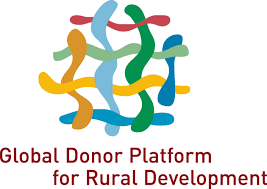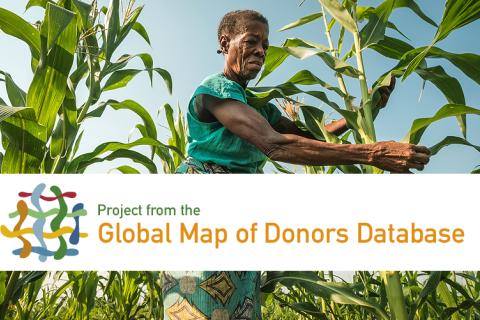The Global Donor Platform for Rural Development is a network of 38 bilateral and multilateral donors, international financing institutions, intergovernmental organisations and development agencies.
Members share a common vision that agriculture and rural development is central to poverty reduction, and a conviction that sustainable and efficient development requires a coordinated global approach.
Following years of relative decline in public investment in the sector, the Platform was created in 2003 to increase and improve the quality of development assistance in agriculture, rural development and food security.
// Agriculture is the key to poverty reduction
Agriculture, rural development, and food security provide the best opportunity for donors and partner country governments to leverage their efforts in the fight against poverty.
However, the potential of agriculture, rural development and food security to reduce poverty is poorly understood and underestimated.
Cutting-edge knowledge of these issues is often scattered among organisations, leading to competition, duplication of efforts, and delays in the uptake of best practices.
// Addressing aid effectiveness
Therefore the Platform promotes the principles of the Paris Declaration on Aid Effectiveness, the Accra Agenda for Action for sustainable outcomes on the ground, and the Busan Global Partnership for Effective Development Cooperation.
Increasing aid to agriculture and rural development is not enough. Donors must work together to maximise development impact.
// Adding value
The Platform adds value to its members’ efforts by facilitating the exchange of their development know-how, which consolidates into a robust knowledge base for joint advocacy work.
Working with the Platform, members are searching for new ways to improve the impact of aid in agriculture and rural development.
- An increased share of official development assistance going towards rural development
- Measurable progress in the implementation of aid effectiveness principles
- Greater use of programme-based and sector-wide approaches
- More sustainable support to ARD by member agencies
// Vision
The Platform endorses and works towards the common objectives of its member institutions to support the reduction of poverty in developing countries and enhance sustainable economic growth in rural areas.
Its vision is to be a collective, recognised and influential voice, adding value to and reinforcing the goals of aid effectiveness in the agricultural and rural development strategies and actions of member organisations in support of partner countries.
// Evaluation
Between August and October 2014, the Global Donor Platform for Rural Development underwent an Evaluation. The evaluators interviewed across board focal points (FPs) of member organisations, partner institutions, staff of the secretariat and key agricultural and rural development experts from different organisations involved in the Platform initiatives. KIT reviewed Platform documentation of the past 10 years, online resources and services to complete the assessment.
According to the report, the change in overall global development objectives of the Post-2015 agenda and its sustainable development goals (SDG) will only reiterate the relevance of the Platform’s work in coordinating donor activities. Agriculture and rural development are incorporated in many of the SDGs. The targeted development of appropriate policies and innovative strategies will depend on increased, cross-sectoral cooperation which the Platform stands for. The achievement of the Platform’s objectives of advocacy, knowledge sharing and network facilitation functions remains to be a crucial contribution to agriculture and rural development.
Members:
Resources
Displaying 211 - 215 of 808Family Farming Development Programme in Maradi, Tohoua and Zinder Regions (PRODAF)
General
The programme aims to help sustainably guarantee food and nutrition security and rural households' resilience to crises in the Maradi, Tahoua and Zinder regions. It aims to increase the income of 290,000 farmer households, their resilience to external shocks, including climate change, and their access to local, urban and regional markets. Sustainable land and watershed management practices will improve water infiltration in the aquifer, reduce erosion and silting, and will thus help to mitigate the constraints and effects of climate change in watershed areas. Activities address the recovery of 10,450 ha of degraded land and 7000 ha of watershed areas, the fixation of dunes around the basins on about 2000 ha and the development of 2500 ha of silvo-pastoral area. Further it is planned to develop a small-scale irrigation system on 5000 ha land. With regard to natural resource governance, the programme will support the wide dissemination of the existing legislation, the assessment of the land tenure situation before and after programme interventions, the negotiation of sustainable management methods for the developed land and the formation or revitalization of community organizations. These activities will enhanced through the continuous support to Niger's Rural Code and to land commissions at different levels.
Support for Responsible Land and Natural Resource Governance in Communal Lands of Kenya
General
The main objective of the project is to support the government’s efforts to secure and improve equitable access to land and natural resources for food security and socio-economic development of agro-pastoral communities in the ASALs of Kenya. The project will adopt mainstreaming of the Voluntary Guidelines on the Responsible Governance of Tenure of Land, Fisheries and Forests in the context of National Food Security and the Framework and Guidelines (F&G) on Land Policy in Africa.
Establishment of a new real estate cadastre system for Serbia
General
Specification of a new IT system for cadastral registration, piloting data migration
Preparation of Integrated Geographic Information for Marine and Coastal Water Management
General
Establishing a National Marine Spatial Data Infrastructure as a basis for the Portuguese UNCLOS claim to extend the continental shelf
Real Estate Registration
General
The project objective is to ensure that there is a reliable, transparent and efficient real estate registration system supporting the real property markets and suitable systems for the management and use of State-owned immovable property. To achieve this, the project will: 1) improve the physical condition of the registration office premises and installation of automated systems and on-line services to provide more effective and efficient customer services in the registration of property rights (Activities include:(i) the development of new buildings and renovation of existing buildings; (ii)the supply of office equipment, furniture and computer systems; (iii) the development of a unified registration and cadastre system providing improved service provision, archiving and on-line access to notaries and other professionals; (iv) providing a complete real estate cadastre and building inventory; (v) improvement in the property valuation system; (vi) improving public awareness; (vii) improving the ongoing sustainability of the registration services through strategic and business planning; and (viii) pilot activities to analyze the scope and inventory illegal and unplanned development and the preparation of a Formalization Strategy for resolving these issues); 2) support improvements in the management of state property (Activities include: (i) improving the administrative systems and service delivery; and (ii) improving the automated State Property Management System); 3) provide the basic geodetic, mapping and cadastral data for the automated property registration and state property management systems (Activities include: (i) Establishing a series of 30-40 Continuously Operating Reference Stations (CORS) to be used for current and future survey work in all disciplines; (ii) the production of a complete set of digital orthophotomaps through new satellite and aerial imagery; (iii)development of land parcel maps; and (iv) improving the ongoing sustainability of these services through strategic and business planning); and 4) coordinate joint activities relating to: (i) training; (ii) developing a joint information technology/ information management strategy; and (iii)policy and legislative development.


